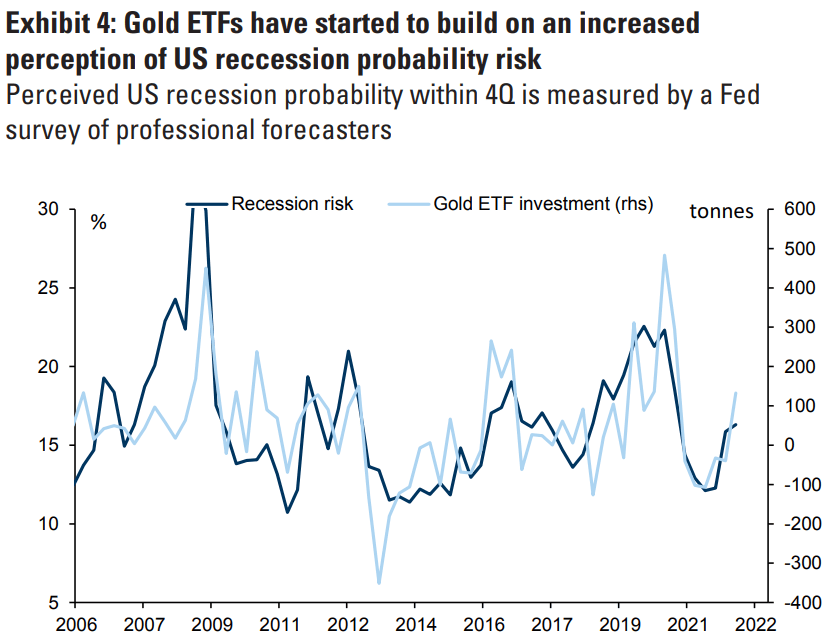Gold Prices Are Rising: How High Can They Go?
- Written by: James Skinner
-
- Gold prices up 10% in 2022 but rally set to extend
- Upgraded Goldman Sachs forecasts suggest $2,500
- Implies further 25% increase, with multiple drivers
- Central bank bids offer significant boost short-term
- But investment & retail buying also drivers in 2022

Image © Adobe Stock
Gold has risen by almost a double-digit percentage in the early months of the year but some influential forecasters are tipping further significant upside as likely throughout the remainder of 2022, and there’s a cocktail of fundamental drivers at play that could yet drive the rally further.
The gold price has long been highly sensitive to the ebb and flow of inflation in the U.S. and other economies, while often sharing a strong correlation with the price of oil which is itself a powerful driver of inflation and a leading indicator of the gold price trajectory.
It’s no secret nor is it news that inflation has risen almost across the globe and that it could rise further still as a result of rampant increases in prices of oil, natural gas and other commodities including those of the agricultural variety.
But these are just some of the factors that could be likely to drive the gold price higher in the months and quarters ahead.
“The recent rally across commodities and rising global geopolitical uncertainty means that our upside scenario on gold investment and central bank demand is now becoming the base case,” says Mikhail Sprogis, a metals strategist at Goldman Sachs.
Source: Goldman Sachs Global Investment Research. Click image for closer inspection.
“We now expect all three major components of gold demand to increase strongly in 2022. The last time that we saw all major demand drivers accelerate simultaneously was in 2010-2011 when gold rallied by almost 70%,” Sprogis and colleagues said in a Monday research briefing.
Sprogis and colleagues upgraded their three, six and 12-month forecasts for U.S. Dollar gold prices on Monday to $2300, $2500 and $2500 per ounce respectively, reflecting increases from earlier projections of $1950, $2050 and $2150.
They cite anticipated demand from investors connected with recent and ongoing increases in economic risks, which are multifaceted, with retail buying expected to remain elevated over the remainder of the year.
However, the uptick in demand from central banks is expected to be significant too, even outpacing the increase seen in 2021 when monetary authorities in India, Brazil and Thailand featured as just a handful of those who returned to the market last year.
Source: Goldman Sachs Global Investment Research. Click image for closer inspection.
“As the Russian Ukraine conflict deteriorated and Russian CB reserves held in G-7 economies were frozen, we argued that Russia will not only not sell its gold reserves but will likely return to being a large gold buyer after the Ruble stabilizes,” Sprogis says.
“Russian gold production is around 370 tonnes per year and it is possible that a significant amount, if not all of it, will be bought by the central bank or other government subsidiaries. We also argued that, given Russia's experience with FX reserves, it is possible that other countries may prefer to hold a larger share of their reserves in gold over the long run as well,” Sprogis and colleagues explained.
The forecast upgrades come after G7 countries and the European Union announced one of the most aggressive financial sanctions packages to be imposed on any G20 country to date, including a freeze on the official reserve assets (savings) of the Central Bank of Russia (CBR).
More than three quarters of the CBR’s roughly $631BN of reserves were held in foriegn currencies and most of those were currencies of G7 economies, although there have also been other sanctions too and all of them aim to block the Russian government's access to the international financial system.
Source: MUFG. Click image for closer inspection.
As an indication of just how significant the sanctions response has been, the BBC reported on Thursday that the Bank for International Settlements - a central bank for central bankers - has suspended the CBR’s accounts there when even the Nazi regime was able to avail of BIS services during the second world war.
“The President of the Bank is an American citizen and the conduct of the Bank, which is guided by a strict policy of neutrality, is wholly in his hands,” Chancellor of the Exchequer Sir Kingsley Wood explained to the House of Commons in October 1942 following a multi-year controversy over a what was then a legal transfer of Czechslovakian gold reserves.
With access to the international financial system increasingly diminishing, the Central Bank of Russia has few options for building national savings other than to resort to gold, although it’s also the case that some other central banks out there may now also be interested to increase their holdings of the precious metal due to the potentially-game-changing nature of the sanctions announced
“Given these Russian sanctions highlight the “weaponization” of not just the dollar but all major developed currencies, it does open up the prospect of a further diversification into other investments. Gold holdings by global central banks have been rising,” says Derek Halpenny, head of research, global markets EMEA and international securities at MUFG.
“In the US today, a bipartisan group of senators is seeking to present a bill that would curtail Russia’s ability to liquidate its gold holdings. This would entail secondary sanctions on any US entity knowingly transacting or transporting Russia’s holdings of gold. If implemented and followed, it would greatly reduce a further source of financing and restrict international reserves even further,” Halpenny and the MUFG team also cautioned.
Above: Gold price shown at monthly intervals alongside U.S. annual inflation rate and Brent crude oil price. Click image for closer inspection.

